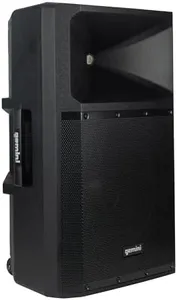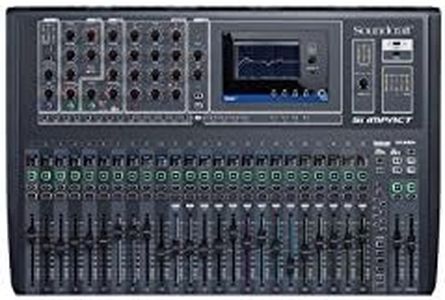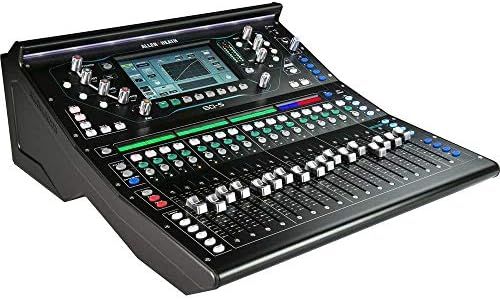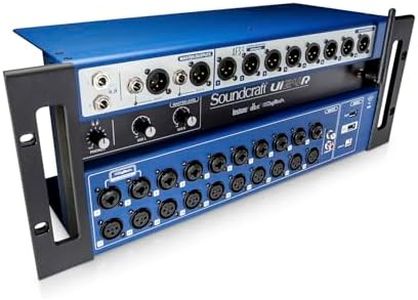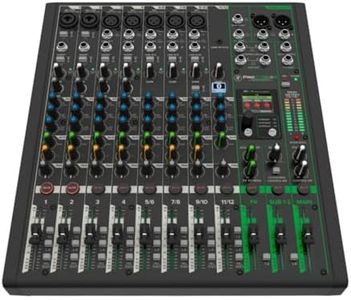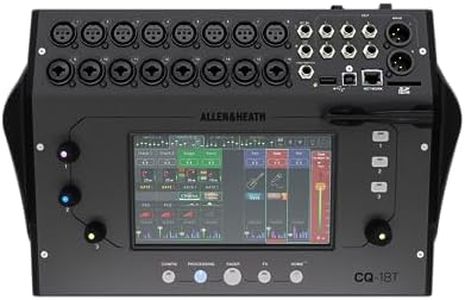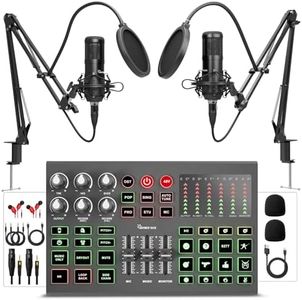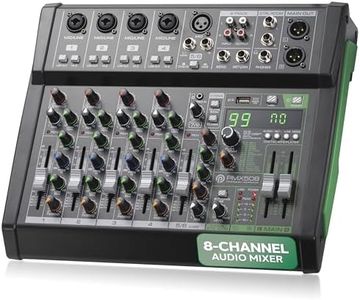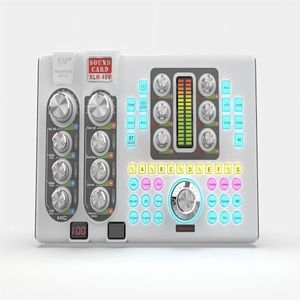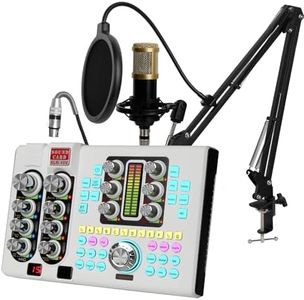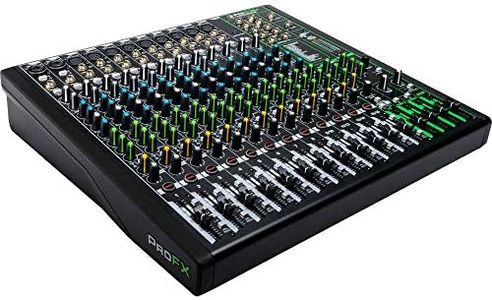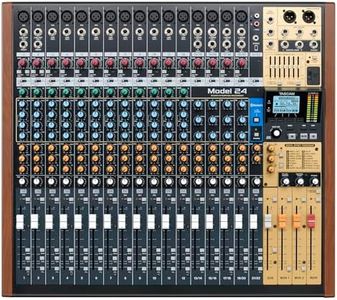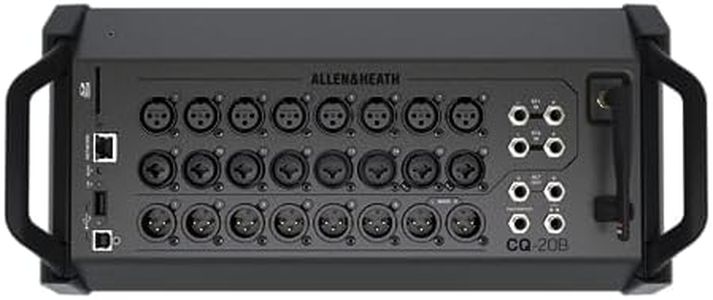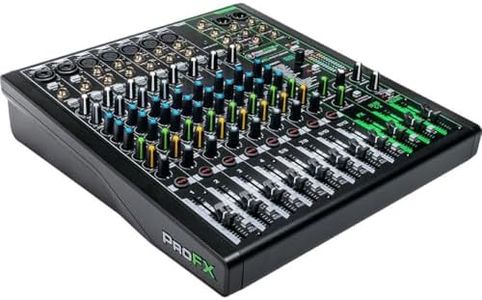10 Best Sound Mixers 2025 in the United States
Our technology thoroughly searches through the online shopping world, reviewing hundreds of sites. We then process and analyze this information, updating in real-time to bring you the latest top-rated products. This way, you always get the best and most current options available.

Our Top Picks
Winner
Soundcraft Si Impact 40-Channel Digital Mixer Console with Remote iPad Control
Most important from
15 reviews
The Soundcraft Si Impact is a robust digital mixer designed for serious audio professionals. It offers an impressive 40 DSP input channels, including 32 mic inputs and 8 XLR/1/4" combi-jacks, providing wide versatility for various audio sources. The console features a fully parametric 4-band EQ on each channel and bus, allowing extensive sound shaping and refining of audio signals.
One standout feature is its 31 output busses, all equipped with full DSP processing and graphic equalization, providing comprehensive routing and mixing capabilities. Additionally, the remote control via iPad adds a layer of flexibility, allowing for adjustments from different locations within a venue. Connectivity is well-covered with USB interface options, although it is worth noting this device is corded electric and not battery-powered, which may limit its portability.
With a weight of 44.1 pounds, it's on the heavier side, making it less portable compared to other mixers. The user interface is designed to be intuitive, but users without digital mixer experience might encounter a learning curve. This mixer is ideal for users who need a powerful, feature-rich digital mixer for fixed installations or larger audio setups, rather than those requiring frequent transport.
Most important from
15 reviews
Allen & Heath SQ-5 Digital Mixer, 48 Input Channels, 7" Capacitive Touchscreen, Automatic Mic Mixing, 32×32 USB Audio Interface, Black
Most important from
12 reviews
The Allen & Heath SQ-5 Digital Mixer is a robust choice for those needing a professional-grade sound mixer. It stands out with its impressive 48 input channels, making it suitable for complex audio setups. The digital nature of the mixer ensures high-quality sound processing with less than 0.7ms latency, which is excellent for live performances and studio recordings.
Its 7-inch capacitive touchscreen simplifies navigation and control, enhancing the user interface experience. Additionally, the automatic mic mixing and built-in effects like DEEP plug-ins and 8 stereo FX engines add versatility to your mixing capabilities. Connectivity is robust with a 32×32 USB audio interface and various output options, including AES and XLR, providing flexibility for different audio setups and expansions.
However, at 29.3 pounds, it is not the most portable option available, making it more suitable for stationary setups rather than frequent transportation. While the mixer is rack-mountable, its size might still be a consideration for those with limited space. Despite these minor drawbacks, the SQ-5's comprehensive features and high-quality performance make it an excellent choice for professional audio engineers and serious hobbyists looking for a reliable and versatile digital mixer.
Most important from
12 reviews
Soundcraft Ui24R Rack-Mountable Laptop or Tablet-Controlled, 24 input Digital Audio Mixer with onboard Signal Processing. Blue and Gray
Most important from
962 reviews
The Soundcraft Ui24R is a versatile 24-channel digital audio mixer designed for users who want flexible control and high-quality sound without complicated hardware interfaces. Its standout feature is the ability to be controlled remotely via tablets, phones, or computers using Wi-Fi or Ethernet, which means you can manage your mix from anywhere in the room or even off-site if needed. This is ideal for live performances, venues, or studios where multiple people may want to adjust the sound simultaneously.
With 24 inputs including combo XLR/1/4" jacks, dedicated XLR outputs, and USB connectivity, it covers a broad range of analog and digital sources. The mixer also supports multi-track recording directly to USB drives or connected computers, which is great for capturing live shows or rehearsals without extra gear. Built-in effects from industry names like dbx, DigiTech, and Lexicon provide professional-quality signal processing, including reverb, delay, chorus, noise gates, and compressors. This helps shape your sound without needing external equipment. The user interface is software-based and controlled via your device screen, which makes physical hardware minimal but may require some getting used to if you prefer tactile knobs and sliders.
Weighing about 2.1 kg and rack-mountable, it’s portable enough for touring but may not be the best choice if you need something ultra-compact for casual or small-scale use. Some users might find the dependency on tablets or laptops for control a bit limiting compared to traditional mixers with onboard controls. The Ui24R performs well for musicians, sound engineers, and venues looking for a powerful, flexible mixer with excellent connectivity and built-in effects. It may be a bit complex for beginners solely wanting a simple hardware mixer but offers great value for those comfortable with digital interfaces and remote control.
Most important from
962 reviews
Buying Guide for the Best Sound Mixers
Choosing the right sound mixer can significantly impact the quality of your audio production, whether you're working on music, podcasts, live events, or film. A sound mixer, also known as an audio mixer or mixing console, allows you to combine, process, and adjust multiple audio signals. To find the best fit for your needs, it's essential to understand the key specifications and how they align with your specific requirements. Here are the main specs to consider when selecting a sound mixer.FAQ
Most Popular Categories Right Now
